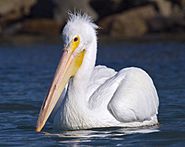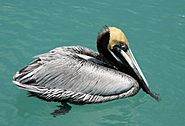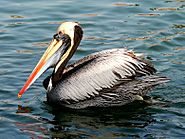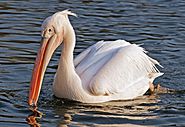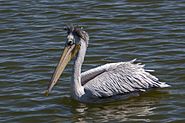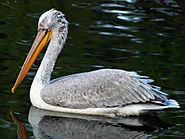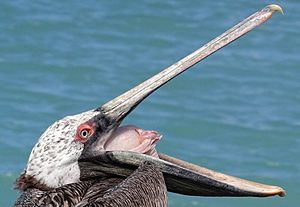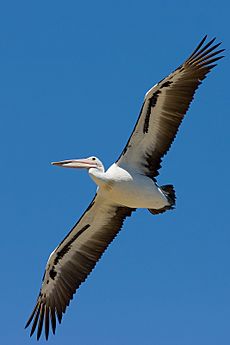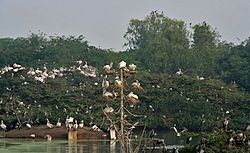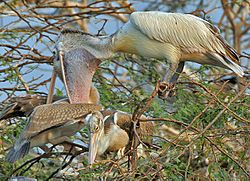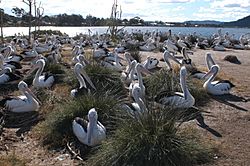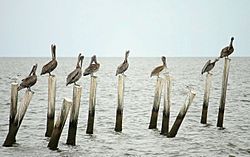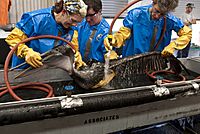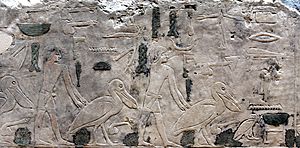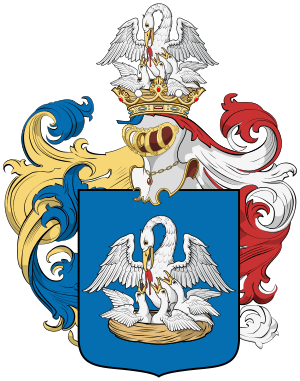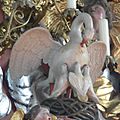Pelican facts for kids
Quick facts for kids Pelican |
|
|---|---|
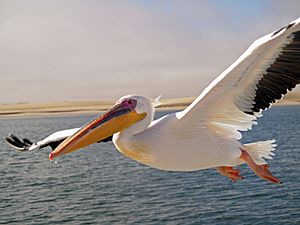 |
|
| A great white pelican in breeding condition flying over Walvis Bay, Namibia. | |
| Scientific classification |
|
| Kingdom: | Animalia |
| Phylum: | Chordata |
| Class: | Aves |
| Order: | Pelecaniformes |
| Family: | Pelecanidae |
| Genus: | Pelecanus Linnaeus, 1758 |
| Type species | |
| Pelecanus onocrotalus Linnaeus, 1758
|
|
| Species | |
|
8, see text |
|
Pelicans are large water birds that belong to the family Pelecanidae. They are known for their huge throat pouches, which they use to catch fish. Pelicans have lived on Earth for at least 36 million years!
Contents
What is a Pelican?
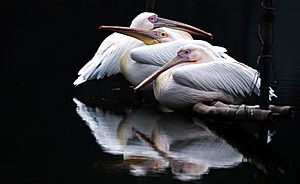
The word "pelican" comes from an Ancient Greek word, pelekan. This word is related to pelekys, which means "axe". Long ago, this word was used for both pelicans and woodpeckers.
The scientist Carl Linnaeus first officially described pelicans in 1758. He noted their straight bill with a hook at the end, their bare face, and their fully webbed feet.
Types of Pelicans: Living Species
There are eight different kinds of pelicans alive today. Each one has unique features and lives in different parts of the world.
| Living species of Pelecanus | |||
|---|---|---|---|
| Common and binomial names | Image | Description | Where they live and their status |
| American white pelican Pelecanus erythrorhynchos Gmelin, 1789 |
These pelicans are about 1.3 to 1.8 meters (4 to 6 feet) long. Their wingspan can be 2.4 to 2.9 meters (8 to 9.5 feet). They weigh 5 to 9 kilograms (11 to 20 pounds). They are mostly white, but their wing feathers are black and can be seen when they fly. | They breed in Canada and the United States. They spend winter in the southern U.S., Mexico, and Central America. They are not currently endangered. | |
| Brown pelican Pelecanus occidentalis Linnaeus, 1766 |
This is the smallest pelican, up to 1.4 meters (4.5 feet) long. Its wingspan is 2 to 2.3 meters (6.5 to 7.5 feet). It weighs 3.6 to 4.5 kilograms (8 to 10 pounds). It has brown feathers and dives headfirst into the water to catch fish. | They live along the coasts from North America and the Caribbean to northern South America and the Galapagos Islands. They are not currently endangered. | |
| Peruvian pelican Pelecanus thagus Molina, 1782 |
These pelicans can be up to 1.5 meters (5 feet) long. Their wingspan is about 2.5 meters (8 feet). They weigh around 7 kilograms (15 pounds). They are dark with a white stripe on their head and neck. | They live along the Pacific Coast of South America, from Ecuador and Peru down to southern Chile. They are considered "near threatened," meaning their population is decreasing. | |
| Great white pelican Pelecanus onocrotalus Linnaeus, 1758 |
These pelicans are 1.4 to 1.75 meters (4.5 to 5.7 feet) long. Their wingspan is 2.45 to 2.95 meters (8 to 9.7 feet). They weigh 10 to 11 kilograms (22 to 24 pounds). They have white feathers with pink skin around their face and pink legs. | They are found in parts of the Mediterranean, Asia, and South Africa. They are not currently endangered. | |
| Australian pelican Pelecanus conspicillatus Temminck, 1824 |
These pelicans are 1.6 to 1.9 meters (5.2 to 6.2 feet) long. Their wingspan is 2.3 to 2.5 meters (7.5 to 8.2 feet). They weigh 4 to 8.2 kilograms (9 to 18 pounds). They are mostly white with black wing feathers and a very large, pale pink bill. | They live in Australia and New Guinea. They sometimes visit New Zealand and other Pacific islands. They are not currently endangered. | |
| Pink-backed pelican Pelecanus rufescens Gmelin, 1789 |
These pelicans are 1.25 to 1.32 meters (4.1 to 4.3 feet) long. Their wingspan is 2.65 to 2.9 meters (8.7 to 9.5 feet). They weigh 3.9 to 7 kilograms (8.6 to 15 pounds). They have grey and white feathers, sometimes with a pinkish tint on their back. They have a yellow upper bill and a grey pouch. | They live in Africa, the Seychelles, and southwestern Arabia. They are not currently endangered. | |
| Dalmatian pelican Pelecanus crispus Bruch, 1832 |
This is the largest pelican, 1.6 to 1.8 meters (5.2 to 5.9 feet) long. Its wingspan is 2.7 to 3.2 meters (8.8 to 10.5 feet). It weighs 10 to 12 kilograms (22 to 26 pounds). It has curly feathers on its neck, grey legs, and greyish-white feathers. | They live from southeastern Europe to India and China. They are considered "near threatened." | |
| Spot-billed pelican Pelecanus philippensis Gmelin, 1789 |
These pelicans are 1.27 to 1.52 meters (4.2 to 5 feet) long. Their wingspan is about 2.5 meters (8.2 feet). They weigh around 5 kilograms (11 pounds). They are mostly grey-white with a grey crest on their neck during breeding season and spots on their bill pouch. | They live in southern Asia, from Pakistan to Indonesia. They are considered "near threatened." | |
Pelican Features and Appearance
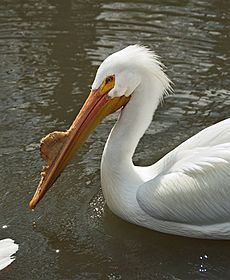
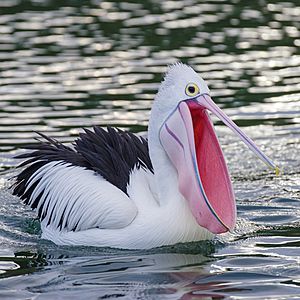
Pelicans are very large birds with long bills. They have a huge pouch under their lower bill. This pouch works like a basket to catch fish and sometimes even rainwater.
Pelicans have long necks and short, strong legs with large, fully webbed feet. Even though they look big and heavy, they are quite light for their size. This is because they have air pockets in their bones and under their skin. These air pockets help them float high in the water. They also cushion the pelican when it dives into the water to catch fish.
Their tail is short and square. Their wings are long and wide, perfect for soaring and gliding in the air. Pelicans have many secondary flight feathers, which helps them fly so well.
Male pelicans are usually bigger than females and have longer bills. Most pelicans have light-colored feathers, except for the brown and Peruvian pelicans. Young pelicans have darker feathers than adult pelicans. When they first hatch, chicks are pink and featherless. They turn grey or black after a few days, then grow soft white or grey down.
Where Pelicans Live
Pelicans live in many different places around the world, from warm tropical areas to cooler temperate zones. However, you won't find them in the middle of South America, in very cold polar regions, or far out in the open ocean.
Pelican Habitats and Behavior
Pelicans like to be near water, both inland lakes and rivers, and coastal areas. They mainly eat fish, which they catch at or near the water's surface.
Pelicans are very social birds. They travel in groups, hunt together, and nest in large colonies. The four white-feathered pelican species usually build their nests on the ground. The four brown or grey-feathered species mostly nest in trees.
Pelicans are excellent swimmers because of their strong legs and webbed feet. They rub their heads on special glands to get an oily substance. They then spread this oil over their feathers to make them waterproof. When floating, pelicans keep their wings loose against their bodies, so only a small part of their body is underwater.
Adult pelicans communicate using their wings and bills. To warn another bird, they might snap their bills or lift and wave their wings. Adult pelicans usually make grunting sounds only when they are in their colony. Outside of breeding season, they are mostly quiet. However, colonies can be very noisy because the chicks make a lot of sounds.
Pelican Reproduction and Life Cycle
Pelicans stay with one partner for a single breeding season. To start a family, they need a nest. The male pelican brings materials for the nest. Ground-nesting species might carry materials in their pouch, while tree-nesting species carry them in their bill. The female then piles the materials to make a simple nest.
Pelican eggs are oval, white, and have a rough texture. Most species lay at least two eggs, but usually one to three. Both parents take turns sitting on the eggs to keep them warm. This incubation period lasts about 30 to 36 days. If undisturbed, up to 95% of eggs can hatch. However, in the wild, often only one chick survives due to competition with its siblings.
Both parents feed their young. When chicks are small, parents feed them by bringing up food from their own stomachs. After about a week, the chicks are big enough to put their heads into their parents' pouches to feed themselves. Sometimes, after being fed, a pelican chick might act like it's having a "tantrum." It might make loud noises, drag itself around with one wing and leg, and even hit its head. This behavior might be a way for the chick to get more attention and food from its parents.
Parents of ground-nesting pelicans sometimes gently pull older chicks by the head before feeding them. When chicks are about 25 days old, they gather in groups called "pods" or "crèches" with up to 100 other young birds. In these groups, parents only feed their own offspring. By 6 to 8 weeks, the young birds start exploring and swimming. They might even practice hunting together. Young pelicans learn to fly ("fledge") 10 to 12 weeks after hatching. They might stay with their parents for a while but are rarely fed after this. Pelicans become adults and can have their own young when they are three or four years old.
Pelicans usually live for 15 to 25 years in the wild. One pelican in captivity lived to be 54 years old!
What Pelicans Eat
Pelicans mainly eat fish. But sometimes, they also eat frogs, turtles, crabs, insects, other birds, and even small mammals.
In deep water, white pelicans often hunt alone. Closer to shore, several pelicans might work together. They form a line or circle around groups of small fish. They beat their wings on the water to drive the fish into shallow areas, then scoop them up with their pouches. While all pelicans can hunt in groups or alone, Dalmatian, pink-backed, and spot-billed pelicans prefer to hunt by themselves. When hunting together, pelicans are known to cooperate. Dalmatian pelicans have even been seen working with great cormorants to catch fish.
When pelicans catch large fish, they grab them with the tip of their bill. Then, they toss the fish into the air and catch it head-first, so it slides down their throat easily. Sometimes, a gull might land on a pelican's head, peck at it to distract it, and steal a fish from its open bill! Pelicans also sometimes steal food from other waterbirds.
Pelicans can also eat other birds. In southern Africa, great white pelicans often eat the eggs and chicks of Cape cormorants. They have also been seen eating chicks of Cape gannets, and even adult African penguins. Australian pelicans have been recorded eating young Australian white ibis and young and adult grey teals and silver gulls. Brown pelicans have been seen eating young common murres in California and the eggs and chicks of cattle egrets and great egrets in Mexico. Peruvian pelicans in Chile have eaten young imperial shags, young Peruvian diving petrels, and grey gulls.
Pelicans and Humans
The relationship between pelicans and people has sometimes been difficult. People have hunted pelicans because they thought the birds were competing with them for fish. However, pelicans usually eat different kinds of fish than humans catch.
Besides losing their homes and being hunted, pelicans can also be harmed by people visiting their breeding colonies. Birdwatchers, photographers, and curious visitors can disturb the birds. When disturbed, pelicans might accidentally break or move their eggs. They might also leave their young exposed to predators or bad weather, or even leave their colonies entirely.
Since pelicans are waterbirds that eat fish, they are greatly affected by oil spills. They can get covered in oil themselves, and their food sources can be harmed. For example, after the 2010 Deepwater Horizon oil spill, hundreds of brown pelicans were found covered in oil. Many more were believed to have been harmed.
When pelicans are near fishing areas, they can get caught on fish hooks or tangled in fishing lines. Hooks can get stuck in their pouch or feet. Strong fishing lines can wrap around their bills, wings, or legs. This can cause injuries, starvation, and often death. Because of this, volunteer groups have been created in places like North America and Australia to rescue and help injured pelicans.
Threats and Conservation Efforts
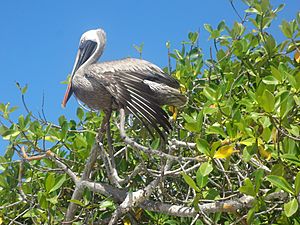
Pelican populations have decreased due to habitat destruction, disturbances from humans, and pollution. Three species are now a concern for conservation. The Peruvian pelican, the spot-billed pelican, and the Dalmatian pelican are all listed as "near threatened." This means their numbers are getting lower.
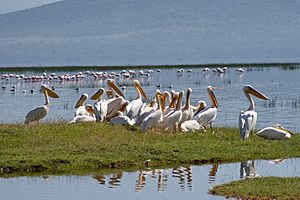
Here are some estimates of pelican populations:
- The total number of brown and Peruvian pelicans is about 650,000 birds.
- The National Audubon Society estimates there are 300,000 brown pelicans worldwide.
- There are an estimated 13,000 to 18,000 spot-billed pelicans.
- The American white pelican population has grown, with over 157,000 birds in 2005.
- The Australian pelican population is generally estimated to be between 300,000 and 500,000 birds.
Pelicans in Culture and History
Pelicans have been important symbols in stories, religions, and art for a very long time.
Ancient Egypt
In Ancient Egypt, the pelican was called henet. It was linked to death and the afterlife. Pictures of pelicans were found on tomb walls and in ancient writings. They were seen as a protective symbol against snakes. The henet was also called the "mother of the king" and was sometimes seen as a goddess. Egyptians believed the pelican could help guide someone safely through the underworld after they died.
Australia
An old story from the Murri people in Australia explains how the Australian pelican got its black and white feathers. The story says the pelican used to be all black. During a flood, he built a canoe to save drowning people. He fell in love with a woman he rescued, but she and her friends tricked him and escaped. The pelican then put white clay on himself like war paint to fight them. But before he finished, another pelican saw him looking so strange and killed him. Since then, all pelicans have been black and white.
Christian Symbolism
An old Christian text from the 3rd or 4th century, called the Physiologus, tells a story about pelicans. It says that pelicans kill their young when they grow up and hit their parents. Then, the mother cries for three days. After that, she wounds her own side and brings her young back to life with her blood. This story was used to explain how people's actions hurt God, and how Jesus sacrificed himself to save people. This story was copied and shared widely during the Middle Ages.
In a later medieval version of the myth, the pelican was seen as a very caring parent. It was believed to wound its own chest to feed its young with its blood when there was no other food. Because of this, the pelican became a symbol of Jesus's sacrifice and the Eucharist. Jesus was sometimes called the "loving divine pelican" whose blood could save the world.
Queen Elizabeth I of England used the pelican as her symbol. She saw herself as the "mother of the Church of England." A famous painting of her, called the Pelican Portrait, was made around 1573.
How the Legend Started
The stories about pelicans hurting themselves to feed their young might have come from how pelicans really act. A pelican often presses its bill against its chest to empty its pouch. This might have looked like it was stabbing itself. Also, the Dalmatian pelican has a bright red pouch during breeding season. When it rests its bill on its chest, this red color might have made people think of blood.
Pelicans in Heraldry
Pelicans have often been used in heraldry, which is the art of designing coats of arms. They usually represent the Christian idea of the pelican as a caring and self-sacrificing parent.
King John II of Portugal used the pelican as his personal symbol.
The image of the pelican also became linked to the medieval religious holiday of Corpus Christi. Two famous universities in England, Oxford and Cambridge, have colleges named Corpus Christi College. Both of these colleges feature pelicans on their coats of arms.
The medical schools at Charles University in Prague also use a pelican as their symbol. The symbol of the Irish Blood Transfusion Service is a pelican. The heraldic pelican has also been used as a pub name and image.
Modern Uses of the Pelican Symbol
- The brown pelican is the national bird of three Caribbean countries: Saint Kitts and Nevis, Barbados, and Sint Maarten. It appears on their coats of arms.
- It is also the state bird of Louisiana in the United States. Louisiana is even called the "Pelican State." The bird is on the state flag and state seal.
- The pelican is a symbol for many universities in Louisiana, like Louisiana State University and Tulane University. It is also the mascot for the New Orleans Pelicans NBA basketball team and the Lahti Pelicans ice hockey team.
- A white pelican logo is used by the Portuguese bank Montepio Geral.
- A pelican is shown on the back of the Albanian 1 lek coin, made in 1996.
- The name and image were used for Pelican Books, which published non-fiction books.
- The seal of the Packer Collegiate Institute, a school, has shown a pelican feeding its young since 1885.
The pelican is also the subject of a famous limerick poem written by Dixon Lanier Merritt in 1910:
A wonderful bird is the pelican,
His bill will hold more than his belican,
He can take in his beak
Food enough for a week,
But I'm damned if I see how the helican.
Interesting Facts About Pelicans
- Pelicans are most closely related to the shoebill and hamerkop birds.
- The scientific family name for pelicans, Pelecanidae, was created in 1815.
- The bills, pouches, and bare skin on the faces of all pelicans become brightly colored before the breeding season.
- The throat pouch of the Californian brown pelican turns bright red. It fades to yellow after the eggs are laid. The Peruvian pelican's throat pouch turns blue.
- The American white pelican grows a noticeable knob on its bill. This knob falls off once the female lays her eggs.
- The smallest pelican species is the brown pelican. Some small ones can weigh as little as 2.75 kilograms (6 pounds) and be 1.06 meters (3.5 feet) long. Their wingspan can be as small as 1.83 meters (6 feet).
- The largest pelican is believed to be the Dalmatian pelican. It can weigh up to 15 kilograms (33 pounds) and be 1.83 meters (6 feet) long. Its wingspan can reach 3 meters (10 feet).
- The Australian pelican's bill can grow up to 0.5 meters (1.6 feet) long in large males. This is the longest bill of any bird!
- Modern pelicans are found on all continents except Antarctica.
- The great white pelican is the national bird of Romania.
- In Jewish dietary law, eating pelicans is not allowed because they are considered an unclean animal.
- Alcatraz Island was named by the Spanish because many brown pelicans nested there. The word alcatraz comes from an Arabic word for a water-carrying pot, similar to a pelican's pouch.
- The Moche people of ancient Peru often drew pelicans in their art.
- Sir Francis Drake's famous ship was first called Pelican. A pelican also appeared on the British halfpenny coin.
Images for kids
-
Pelican on the Albanian 1 lek coin.
-
Queen Elizabeth I: the Pelican Portrait, by Nicholas Hilliard (circa 1573), where Elizabeth I wears the medieval symbol of the pelican on her chest.
See also
 In Spanish: Pelícanos para niños
In Spanish: Pelícanos para niños


